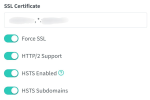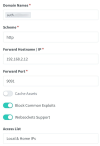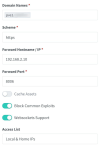Hi everyone, I need some help troubleshooting websockets (at least that's what I think the issue is). If I access Proxmox via 192.168.2.10:8006, the Proxmox console works perfectly. If I access Proxmox via
However, as soon as I add the Authelia code to that "Advanced" section, the Proxmox Console stops working and this is what I see:

Trying to access any of the consoles (regardless of whether it's in pve1 or any of the LXC containers) results in a brief grey banner over the console with "Undefined Error: 1006".
At the moment, after Authelia lets me through, I am logging in as root@pam & not myname@Authelia. I recently found out that only root@pam can access the console. For the sake of completeness, I tried logging in as myname@Authelia as well, and as expected, that did not work:

After spending a few days Googling this, I guess it's something to do with Authelia blocking Websockets, but I do not know nearly enough to know what I should look for, let alone to know how to fix this. As a disclaimer, I am a complete beginner to homelabbing. I have no formal training or experience in anything IT. I literally just started doing this as a hobby in my spare time, becuase I want to try to get some fun stuff set up at home. I am already at the very limits of my knowledge. I'm posting everything that I can think of that might be helpful for troubleshooting, but if you guys require more details, please let me know and I'll post them! Any help would be appreciated
The general workflow I am trying to set up is as follows:
Switch on Wireguard → Open *App* by visiting
I have Proxmox 8 running on a Lenovo M720q. To access Proxmox (or anything on that machine for that matter), I need to either be on my Home network, or be connected to Wireguard (I am using a Ubiquiti UniFi Dream Machine SE which has Wireguard built in) and reach it via the IP address (which is annoying). I have a domain with Cloudflare managing the domain's records (they are proxied). I have an access list set up in Nginx Proxy Manager (running as an LXC container thanks to the Helper Scripts) which only allows 192.168.X.X & my public-facing static IP through to whatever apps have subdomains. Nginx Proxy Manager is also handling the SSL Certificates (I have one wildcard Let's Encrypt Certificate with
Authelia is set up in its own LXC Container (thanks to the Helper Scripts). I followed this tutorial to set it up. The files in
Here's the config file with Domain/IP/Email details sanitised:
In Nginx Proxy Manager, I have one entry for Authelia & one entry for Proxmox.
Both use the same SSL Certificate and have identical "SSL" Tabs:


With the "Advanced" section having:

With the "Advanced" section having:
The only thing I can see in the Authelia Log after successful 2FA is this:
What (all) am I doing wrong? Should I provide any other info that may be helpful?
pve1.mydomain.com while the "advanced" tab of of the Proxy Host in the "Edit Proxy Hosts" window in Nginx Proxy Manager is completely empty, the Proxmox console works perfectly.However, as soon as I add the Authelia code to that "Advanced" section, the Proxmox Console stops working and this is what I see:

Trying to access any of the consoles (regardless of whether it's in pve1 or any of the LXC containers) results in a brief grey banner over the console with "Undefined Error: 1006".
At the moment, after Authelia lets me through, I am logging in as root@pam & not myname@Authelia. I recently found out that only root@pam can access the console. For the sake of completeness, I tried logging in as myname@Authelia as well, and as expected, that did not work:

After spending a few days Googling this, I guess it's something to do with Authelia blocking Websockets, but I do not know nearly enough to know what I should look for, let alone to know how to fix this. As a disclaimer, I am a complete beginner to homelabbing. I have no formal training or experience in anything IT. I literally just started doing this as a hobby in my spare time, becuase I want to try to get some fun stuff set up at home. I am already at the very limits of my knowledge. I'm posting everything that I can think of that might be helpful for troubleshooting, but if you guys require more details, please let me know and I'll post them! Any help would be appreciated
The general workflow I am trying to set up is as follows:
Switch on Wireguard → Open *App* by visiting
subdomain.mydomain.com → Get intercepted by Authelia → Login + 2FA → Authelia grants access to subdomain.mydomain.com → Use Authelia's SSO to login to *App*I have Proxmox 8 running on a Lenovo M720q. To access Proxmox (or anything on that machine for that matter), I need to either be on my Home network, or be connected to Wireguard (I am using a Ubiquiti UniFi Dream Machine SE which has Wireguard built in) and reach it via the IP address (which is annoying). I have a domain with Cloudflare managing the domain's records (they are proxied). I have an access list set up in Nginx Proxy Manager (running as an LXC container thanks to the Helper Scripts) which only allows 192.168.X.X & my public-facing static IP through to whatever apps have subdomains. Nginx Proxy Manager is also handling the SSL Certificates (I have one wildcard Let's Encrypt Certificate with
mydomain.com, *.mydomain.com), and the SSL Mode is set to Full (Strict) in Cloudflare.Authelia is set up in its own LXC Container (thanks to the Helper Scripts). I followed this tutorial to set it up. The files in
/etc/authelia/certs/ are Cloudflare Origin Certificates. I tried to follow Authelia's documentation and tried allowing resources to bypass authentication, but I don't know if I did it right.Here's the config file with Domain/IP/Email details sanitised:
YAML:
########################################
# authelia config
# source: https://florianmuller.com
# #######################################
theme: dark
default_redirection_url: https://auth.mydomain.com/
server:
host: 0.0.0.0
port: 9091
asset_path: /etc/authelia/.assets/
tls:
key: /etc/authelia/certs/mydomain.key
certificate: /etc/authelia/certs/mydomain.crt
log:
level: debug
file_path: /var/log/authelia.log
totp:
issuer: auth.mydomain.com
webauthn:
disable: false
display_name: Authelia
attestation_conveyance_preference: indirect
user_verification: discouraged
timeout: 60s
ntp:
address: "0.de.pool.ntp.org:123"
version: 4
max_desync: 3s
disable_startup_check: false
authentication_backend:
file:
path: /etc/authelia/.users/users_database.yml
password:
algorithm: argon2id
iterations: 1
key_length: 32
salt_length: 16
memory: 1024
parallelism: 8
access_control:
default_policy: deny
networks:
- name: wan-ip
networks:
- '193.my.public.ip'
- name: internal-default
networks:
- '192.168.1.0/24'
- name: internal-trusted
networks:
- '192.168.2.0/24'
- name: internal-iot
networks:
- '192.168.3.0/24'
- name: wireguard
networks:
- '192.168.4.0/24'
rules:
#Bypass Proxmox APIs & Resources on all subdomains
- domain: '*.mydomain.com'
resources:
- '\/api.*\/'
policy: bypass
networks:
- 'wan-ip'
- 'internal-default'
- 'internal-trusted'
- 'wireguard'
#Require 2FA for Proxmox
- domain: 'pve1.mydomain.com'
policy: two_factor
networks:
- 'wan-ip'
- 'internal-default'
- 'internal-trusted'
- 'wireguard'
#Require 2FA for NginxProxyManager
- domain: 'npm.mydomain.com'
policy: two_factor
networks:
- 'wan-ip'
- 'internal-default'
- 'internal-trusted'
- 'wireguard'
session:
name: authelia_session
expiration: 3600 # 1 hour
inactivity: 300 # 5 minutes
domain: mydomain.com
same_site: lax
remember_me_duration: 7d
regulation:
max_retries: 3
find_time: 120
ban_time: 300
storage:
local:
path: /etc/authelia/.db/sqlite3.db
notifier:
disable_startup_check: false
smtp:
host: smtp.mail.yahoo.com
port: 465
timeout: 5s
username: email@yahoo.com
sender: "mydomain Authentification Server <auth@mydomain.com>"
subject: "{title}"
startup_check_address: email@yahoo.com
disable_require_tls: false
disable_html_emails: false
tls:
skip_verify: false
minimum_version: TLS1.2
identity_providers:
oidc:
## The other portions of the mandatory OpenID Connect 1.0 configuration go here.
## See: https://www.authelia.com/c/oidc
clients:
- id: Proxmox
description: Proxmox
secret: '$plaintext$supersecureipromise'
public: false
authorization_policy: two_factor
redirect_uris:
- https://pve1.mydomain.com
scopes:
- openid
- profile
- email
userinfo_signing_algorithm: none
- id: NPM
description: NginxProxyManager
secret: '$plaintext$iswearihaventreusedit'
public: false
authorization_policy: two_factor
redirect_uris:
- https://npm.mydomain.com
scopes:
- openid
- profile
- email
userinfo_signing_algorithm: noneIn Nginx Proxy Manager, I have one entry for Authelia & one entry for Proxmox.
Both use the same SSL Certificate and have identical "SSL" Tabs:

auth.mydomain.com is set up like so:
With the "Advanced" section having:
NGINX:
#Authelia
location / {
set $upstream_authelia https://192.168.2.12:9091;
proxy_pass $upstream_authelia;
client_body_buffer_size 128k;
#Timeout if the real server is dead
proxy_next_upstream error timeout invalid_header http_500 http_502 http_503;
# Advanced Proxy Config
send_timeout 5m;
proxy_read_timeout 360;
proxy_send_timeout 360;
proxy_connect_timeout 360;
# Basic Proxy Config
proxy_set_header Host $host;
proxy_set_header X-Real-IP $remote_addr;
proxy_set_header X-Forwarded-For $proxy_add_x_forwarded_for;
proxy_set_header X-Forwarded-Proto $scheme;
proxy_set_header X-Forwarded-Host $http_host;
proxy_set_header X-Forwarded-Uri $request_uri;
proxy_set_header X-Forwarded-Ssl on;
proxy_redirect http:// $scheme://;
proxy_http_version 1.1;
proxy_set_header Connection "";
proxy_cache_bypass $cookie_session;
proxy_no_cache $cookie_session;
proxy_buffers 64 256k;
# If behind reverse proxy, forwards the correct IP
set_real_ip_from 10.0.0.0/8;
set_real_ip_from 172.0.0.0/8;
set_real_ip_from 192.168.0.0/16;
set_real_ip_from fc00::/7;
real_ip_header X-Forwarded-For;
real_ip_recursive on;
}pve1.mydomain.com is set up like so:
With the "Advanced" section having:
NGINX:
#Proxmox
location /authelia {
internal;
set $upstream_authelia https://192.168.2.12:9091/api/verify; #ADD YOUR IP AND PORT OF AUTHELIA
proxy_pass_request_body off;
proxy_pass $upstream_authelia;
proxy_set_header Content-Length "";
# Timeout if the real server is dead
proxy_next_upstream error timeout invalid_header http_500 http_502 http_503;
client_body_buffer_size 128k;
proxy_set_header Host $host;
proxy_set_header X-Original-URL $scheme://$http_host$request_uri;
proxy_set_header X-Real-IP $remote_addr;
proxy_set_header X-Forwarded-For $remote_addr;
proxy_set_header X-Forwarded-Proto $scheme;
proxy_set_header X-Forwarded-Host $http_host;
proxy_set_header X-Forwarded-Uri $request_uri;
proxy_set_header X-Forwarded-Ssl on;
proxy_redirect http:// $scheme://;
proxy_http_version 1.1;
proxy_set_header Connection "";
proxy_cache_bypass $cookie_session;
proxy_no_cache $cookie_session;
proxy_buffers 4 32k;
send_timeout 5m;
proxy_read_timeout 240;
proxy_send_timeout 240;
proxy_connect_timeout 240;
}
location / {
set $upstream_Proxmox https://192.168.2.10:8006; #CHANGE NAME AND IP AND PORT
proxy_pass $upstream_Proxmox; #change name of the service
auth_request /authelia;
auth_request_set $target_url $scheme://$http_host$request_uri;
auth_request_set $user $upstream_http_remote_user;
auth_request_set $groups $upstream_http_remote_groups;
proxy_set_header Remote-User $user;
proxy_set_header Remote-Groups $groups;
proxy_set_header Access-Control-Allow-Origin *;
error_page 401 =302 https://auth.mydomain.com/?rd=$target_url; #change YOURDOMAIN.COM to your domain
client_body_buffer_size 128k;
proxy_next_upstream error timeout invalid_header http_500 http_502 http_503;
send_timeout 5m;
proxy_read_timeout 360;
proxy_send_timeout 360;
proxy_connect_timeout 360;
proxy_set_header Host $host;
proxy_set_header X-Real-IP $remote_addr;
proxy_set_header X-Forwarded-For $proxy_add_x_forwarded_for;
proxy_set_header X-Forwarded-Proto $scheme;
proxy_set_header X-Forwarded-Host $http_host;
proxy_set_header X-Forwarded-Uri $request_uri;
proxy_set_header X-Forwarded-Ssl on;
proxy_redirect http:// $scheme://;
proxy_http_version 1.1;
proxy_set_header Connection "";
proxy_cache_bypass $cookie_session;
proxy_no_cache $cookie_session;
proxy_buffers 64 256k;
#real_ip_header X-Forwarded-For;
real_ip_header CF-Connecting-IP;
real_ip_recursive on;
}The only thing I can see in the Authelia Log after successful 2FA is this:
Bash:
root@Authelia:~# tail -f /var/log/authelia.log
time="2023-10-27T10:33:00Z" level=debug msg="Check authorization of subject username=myname groups= ip=192.168.2.3 and object https://pve1.mydomain.com/api2/json/cluster/tasks (method )."
time="2023-10-27T10:33:03Z" level=debug msg="Check authorization of subject username=myname groups= ip=192.168.2.3 and object https://pve1.mydomain.com/api2/json/nodes/pve1/status (method )."
time="2023-10-27T10:33:03Z" level=debug msg="Check authorization of subject username=myname groups= ip=192.168.2.3 and object https://pve1.mydomain.com/api2/json/cluster/resources (method )."
time="2023-10-27T10:33:03Z" level=debug msg="Check authorization of subject username=myname groups= ip=192.168.2.3 and object https://pve1.mydomain.com/api2/json/cluster/tasks (method )."
time="2023-10-27T10:33:06Z" level=debug msg="Check authorization of subject username=myname groups= ip=192.168.2.3 and object https://pve1.mydomain.com/api2/json/cluster/resources (method )."
time="2023-10-27T10:33:06Z" level=debug msg="Check authorization of subject username=myname groups= ip=192.168.2.3 and object https://pve1.mydomain.com/api2/json/cluster/tasks (method )."
time="2023-10-27T10:33:08Z" level=debug msg="Check authorization of subject username=myname groups= ip=192.168.2.3 and object https://pve1.mydomain.com/api2/json/nodes/pve1/status (method )."
time="2023-10-27T10:33:09Z" level=debug msg="Check authorization of subject username=myname groups= ip=192.168.2.3 and object https://pve1.mydomain.com/api2/json/cluster/resources (method )."
time="2023-10-27T10:33:09Z" level=debug msg="Check authorization of subject username=myname groups= ip=192.168.2.3 and object https://pve1.mydomain.com/api2/json/cluster/tasks (method )."What (all) am I doing wrong? Should I provide any other info that may be helpful?
Last edited:

